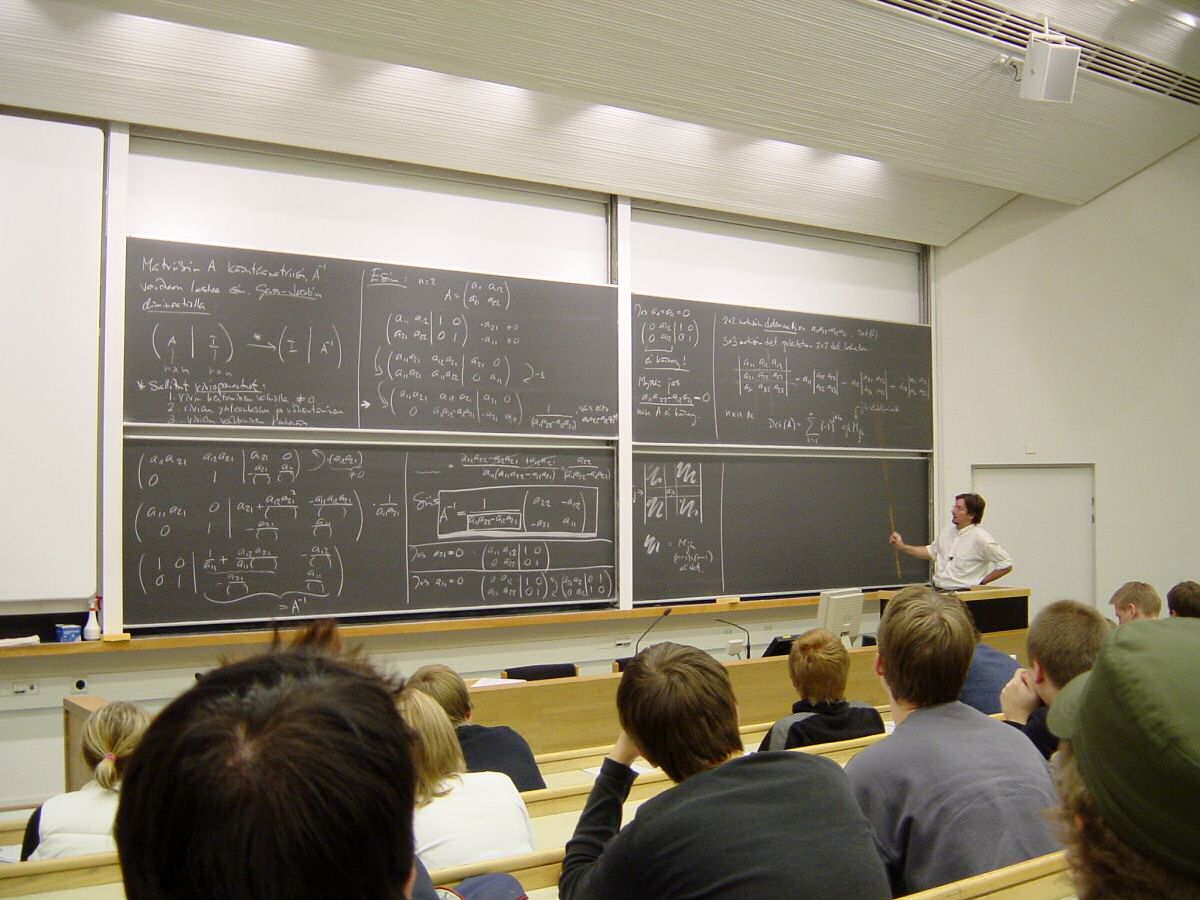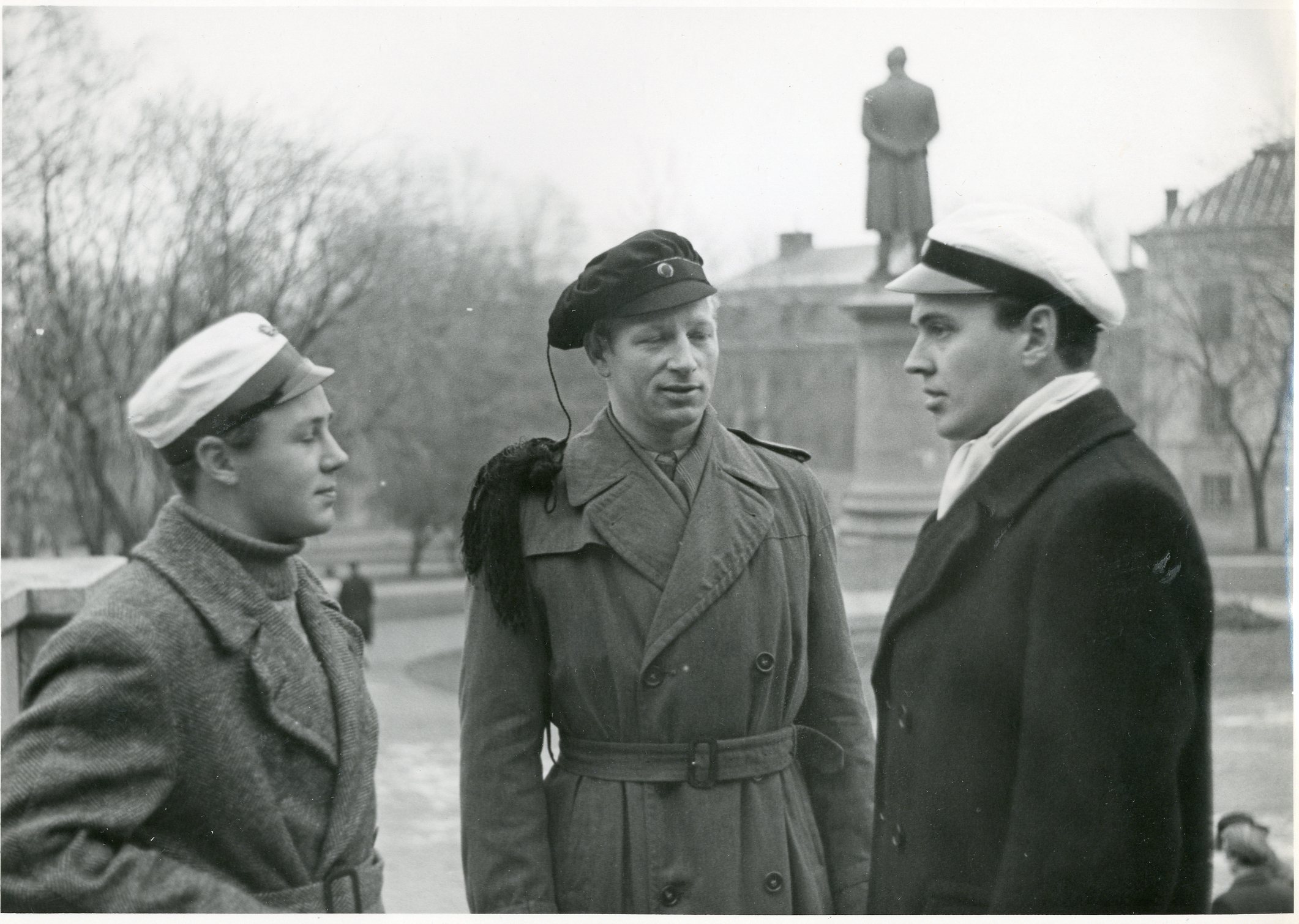|
Teekkari
In Finland, "teekkari" is a term used for students of institutes of technology. The term is also used for students of technical subjects in general universities and Bachelors of Science in Technology. Teekkari culture In technical institutes and faculties, teekkari culture is known for its specific terms, of which part can also be found at other universities: for example the teekkari student cap, wappu, student pranks, guild activities, spexes, sittnings, excursions, student boilersuits and coups. Many different events and parties are held throughout the year at technical institutes. First-year students known as "fuksis" collect attendance points from these events in their score sheets. After reaching a set number of points, a fuksi is entitled to wear a teekkari student cap on the next International Workers' Day on 1 May. Students who fail to reach the set number of points can only wear the cap on the Monday following Mother's Day. There is a tradition in Tampere to lift fres ... [...More Info...] [...Related Items...] OR: [Wikipedia] [Google] [Baidu] |
Otaniemi
Otaniemi ( Finnish), or Otnäs (Swedish), is a district of Espoo, Finland. It is located near the border of Helsinki, the capital of Finland. Otaniemi is located on the southern shore of the Laajalahti bay, next to the district of Tapiola near the border to Helsinki. It is part of the Greater Tapiola major district. Otaniemi and Tapiola are separated by the Ring I beltway. The Aalto University metro station, located in Otaniemi, was taken into use in 2017. Otaniemi is the home of Aalto University's campus, thus "Otaniemi" is often used as a synonym for Aalto. However, several research and business facilities are also located in Otaniemi. The most prominent institutions for science and engineering in Otaniemi are the VTT Technical Research Centre of Finland and the Geological Survey of Finland (GTK). Business is represented in the area by the business incubator Technopolis. In 2010, Otaniemi became home to Aalto University, formed from the merger of the Helsinki University o ... [...More Info...] [...Related Items...] OR: [Wikipedia] [Google] [Baidu] |
Spex (theatre)
Spex ( in Finnish) is a form of amateur comedy theatre act performed by university students in Sweden and parts of Finland. University cities, such as Gothenburg, Lund, Uppsala, and Linköping have long-running traditions of spex. The word is likely derived from abbreviated student slang for ''spektakel'' (spectacle; scene; show). This form of comedy theatre may also be known as Gyckel (buffoonery), when performed at a Gask. History The first spexes were performed possibly as early as the 16th century in Uppsala. Local students were practising Latin by writing short plays in Latin, called spexes. These performances were performed by male-only casts, as all the students at that time were male, and the tradition of gender switching for roles continues today. Over the next 300 years the spexes developed into their modern form, which emerged around 1850 at Uppsala University. The first spexes in Finland were performed at the Helsinki University of Technology at the beginning of the ... [...More Info...] [...Related Items...] OR: [Wikipedia] [Google] [Baidu] |
Student Boilersuit
Student boilersuit (Swedish ''studentoverall'' or ''studenthalare'', Finnish ''opiskelijahaalari, Canadian Flightsuit'' ''or Coveralls or redsuits'') are boilersuits widely used for specific events at universities and polytechnics in Sweden, Finland, and Canada. Typically, the suits are procured by the student associations of faculties or programmes. At the major Swedish universities (like Lund or Uppsala) the use of boilersuits is limited to engineering students, however at Stockholm they are also worn by students of other programs, but their use has spread to students in other fields at some of the smaller university colleges. In Finland, boilersuits have also been foremost identified with engineering students, but see extensive use in all of the student organizations of Finnish institutions of higher learning, such as the University of Helsinki and Aalto University. History and use Student coveralls have become one of the most conspicuous academic traditions at some ed ... [...More Info...] [...Related Items...] OR: [Wikipedia] [Google] [Baidu] |
Student Cap
In various European countries, student caps of different types are, or have been, worn either as a marker of a common identity, as is the case in the Nordic countries, or to identify the wearer as a member of a smaller body within the larger group of students, as is the case with the caps worn by members of German , or student groups in Belgium. Belgium Belgian student caps can be divided into 2 main variants, the ''calotte'', worn by students at Roman Catholic universities and the ''penne'', worn by students at liberal/non-Catholic universities. Calotte The calotte originates from the skullcap worn by the Zouave papal regiment around 1860. The ''calotte'' is cylindrical, made from velvet and astrakhan (pelt of newborn lamb). The color of the top is bordeau red for the universities of Brussels, Leuven, Louvain-la-Neuve and Namur, white for the University of Ghent and emerald for the University of Liège. In the front of the ''calotte'' are stripes representing the Belgian ... [...More Info...] [...Related Items...] OR: [Wikipedia] [Google] [Baidu] |
Espoo
Espoo (, ; sv, Esbo) is a city and municipality in the region of Uusimaa in the Republic of Finland. It is located on the northern shore of the Gulf of Finland, bordering the cities of Helsinki, Vantaa, Kirkkonummi, Vihti and Nurmijärvi while surrounding the enclaved town of Kauniainen. The city covers with a population of about 300 000 residents in 2022, making it the 2nd-most populous city in Finland. Espoo forms a major part of a substantially larger metropolitan area known as Greater Helsinki, home to over 1.5 million people in 2020. Espoo was first settled in the Prehistoric Era, with the first signs of human settlements going back as far as 8,000 years, but the population effectively disappeared in the early stages of the Iron Age. In the Early Middle Ages, the area was resettled by Tavastians and Southwestern Finns. After the Northern Crusades, Swedish settlers started migrating to the coastal areas of present-day Finland, and Espoo was established as a ... [...More Info...] [...Related Items...] OR: [Wikipedia] [Google] [Baidu] |
Oulujoki
Oulujoki is a river in Oulu province, Finland. Its name in Finnish means literally "Oulu River" ( sv, Ule älv), originally in old Northern Ostrobothnian dialect literally "Flood River". Its origin is Oulujärvi and its watershed area covers a significant part of Kainuu region. It flows into the Bothnian Bay at Oulu Oulu ( , ; sv, Uleåborg ) is a city, municipality and a seaside resort of about 210,000 inhabitants in the region of North Ostrobothnia, Finland. It is the most populous city in northern Finland and the fifth most populous in the country after .... Port of Oulu is located at the mouth of the river. External links * Rivers of Finland Rivers of Muhos Rivers of Oulu {{Finland-river-stub ... [...More Info...] [...Related Items...] OR: [Wikipedia] [Google] [Baidu] |
Vaasa
Vaasa (; sv, Vasa, , Sweden ), in the years 1855–1917 as Nikolainkaupunki ( sv, Nikolajstad; literally meaning "city of Nicholas),Vaasa oli ennen Nikolainkaupunki ja Aurinkolahti Mustalahti – paikannimiä ei kuitenkaan pidä muuttaa heppoisin perustein – '' Kaleva'' (in Finnish) is a city on the west coast of . It received its charter in 1606, during the reign of |
Independence Day (Finland)
Independence Day of Finland ( fi, itsenäisyyspäivä; sv, självständighetsdagen) is a national public holiday, and a flag flying day A flag flying day is a day, when it is decreed, either officially or by tradition, that the national flag should be hoisted by every official agency in the country and private citizens and corporations are also recommended to fly the national flag, ..., held on 6 December to celebrate Finland's declaration of independence from the Russian Empire when the Bolsheviks took power in late 1917. History The movement for Finland's independence started after the Russian Revolution (1917), revolutions in Russia, caused by disturbances inside Russia from hardships connected to the World War I, First World War. This gave Finland an opportunity to withdraw from Russian rule. After several disagreements between the non-socialists and the social-democrats over who should have power in Finland, on 4 December 1917, the Senate of Finland, led by Pehr Evind Sv ... [...More Info...] [...Related Items...] OR: [Wikipedia] [Google] [Baidu] |
Mathematics Lecture At The Helsinki University Of Technology
Mathematics is an area of knowledge that includes the topics of numbers, formulas and related structures, shapes and the spaces in which they are contained, and quantities and their changes. These topics are represented in modern mathematics with the major subdisciplines of number theory, algebra, geometry, and analysis, respectively. There is no general consensus among mathematicians about a common definition for their academic discipline. Most mathematical activity involves the discovery of properties of abstract objects and the use of pure reason to prove them. These objects consist of either abstractions from nature orin modern mathematicsentities that are stipulated to have certain properties, called axioms. A ''proof'' consists of a succession of applications of deductive rules to already established results. These results include previously proved theorems, axioms, andin case of abstraction from naturesome basic properties that are considered true starting points of t ... [...More Info...] [...Related Items...] OR: [Wikipedia] [Google] [Baidu] |
Cockade
A cockade is a knot of ribbons, or other circular- or oval-shaped symbol of distinctive colours which is usually worn on a hat or cap. Eighteenth century In the 18th and 19th centuries, coloured cockades were used in Europe to show the allegiance of their wearers to some political faction, or to show their rank or to indicate a servant's livery. Because individual armies might wear a variety of differing regimental Military uniform, uniforms, cockades were used as an effective and economical means of national identification. A cockade was pinned on the side of a man's tricorne or cocked hat, or on his lapel. Women could also wear it on their hat or in their hair. In pre-revolutionary France, the cockade of the House of Bourbon, Bourbon dynasty was all white. In the Kingdom of Great Britain supporters of a Jacobitism, Jacobite restoration wore white cockades, while the recently established House of Hanover, Hanoverian monarchy used a black cockade. The Hanoverians also accorded ... [...More Info...] [...Related Items...] OR: [Wikipedia] [Google] [Baidu] |
Lake Saimaa
Saimaa ( , ; sv, Saimen) is a lake located in the Finnish Lakeland area in southeastern Finland. At approximately , it is the largest lake in Finland, and the fourth largest natural freshwater lake in Europe. The name Saimaa likely comes from a non-Uralic, non-Indo European substrate language. History It was formed by glacial melting at the end of the Ice Age. Major towns on the lakeshore include Lappeenranta, Imatra, Savonlinna, Mikkeli, Varkaus, and Joensuu. About 6000 years ago, ancient Lake Saimaa, estimated to cover nearly at the time, was abruptly discharged through a new outlet. The event created thousands of square kilometres of new residual wetlands. Following this event, the region saw a population maximum in the decades following only to later return to an ecological development towards old boreal conifer forests which saw a decline in population. Topography The Vuoksi River flows from Saimaa to Lake Ladoga. Most of the lake is spotted with islands, and narrow c ... [...More Info...] [...Related Items...] OR: [Wikipedia] [Google] [Baidu] |







